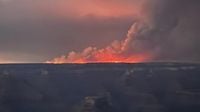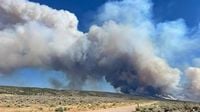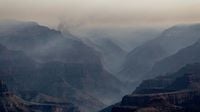A fast-moving wildfire known as the Dragon Bravo Fire has ravaged the North Rim of Grand Canyon National Park, causing widespread destruction and forcing the closure of the area for the remainder of the 2025 season. The blaze, sparked by lightning on July 4, 2025, rapidly expanded amid extreme drought, high winds, and unusually dry, hot weather conditions, consuming over 14 square miles and destroying more than 80 structures, including the historic Grand Canyon Lodge.
The Grand Canyon Lodge, a nearly century-old National Historic Landmark constructed in 1927 and rebuilt in 1936 after a previous fire, was the centerpiece of the North Rim experience. Designed by architect Gilbert Stanley Underwood using native Kaibab limestone and ponderosa pine, the lodge was the last of the early 20th-century National Park lodges to remain intact. It was completely engulfed by flames on the afternoon of July 13, 2025, after the fire intensified overnight due to gusty winds and dry air.
Officials ordered immediate evacuations of guests, staff, and nearby residents as the fire approached. Thanks to swift action, no injuries or fatalities have been reported. However, the fire also destroyed park staff housing, visitor centers, administrative buildings, a water treatment plant, and a wastewater facility, severely impacting the North Rim community and park infrastructure.
Park Superintendent Ed Keable confirmed the loss of the Grand Canyon Lodge and other critical buildings, describing the damage as a tragic blow to the area. “It’s very emotional,” said local visitor Tim Allen, who has long cherished the peaceful and remote nature of the North Rim. Many locals and guides expressed heartbreak over the destruction of a place they considered home and a vital part of the Grand Canyon’s heritage.
The wildfire’s explosive growth caught many by surprise. Initially, the National Park Service (NPS) managed the blaze using a “confine and contain” strategy, allowing it to burn naturally under supervision to support forest health. This approach is common in national forests and aims to reduce future fire risks by chipping away at fuels. However, a dangerous shift in weather disrupted these plans.
According to Robert Rickey, a science and operations officer with the National Weather Service, the fire season experienced a “break in the monsoon pattern,” with several days of extremely dry, warm conditions replacing the usual afternoon showers. Relative humidity plummeted into the single digits, and winds gusted up to 40 mph from the west and northwest. Temperatures soared to the upper 80s and low 90s Fahrenheit, about 10 degrees above average for July.
These atypical weather conditions fueled the fire’s rapid expansion, increasing its size over eightfold on July 11 alone and pushing flames into park structures by July 13. Firefighters and emergency responders, numbering over 350, have been battling the blaze around the clock, employing hand crews, bulldozers, and helicopters to establish containment lines. Despite their efforts, as of July 16, 2025, the fire remained 0% contained.
The North Rim of the Grand Canyon, which normally attracts just over 81,000 visitors annually—about 10% of the park’s total—will remain closed through October 15, the end of its seasonal operation. All visitor services, including lodging, campgrounds, ranger programs, gas stations, visitor centers, and inner-canyon trails such as the North and South Kaibab, Bright Angel, and Phantom Ranch, are unavailable until spring 2026. The South Rim, by contrast, remains open year-round but is under Stage 1 fire restrictions due to ongoing high fire danger and visible smoke affecting air quality.
Travel companies like Intrepid Travel have responded by rerouting trips and encouraging responsible visitation to support conservation and local economies. Leigh Barnes, president of the Americas at Intrepid, emphasized the importance of standing behind those who protect the parks and visiting with respect for the land and wildlife.
The fire’s management has come under intense scrutiny. Arizona Governor Katie Hobbs criticized the federal government’s initial decision to treat the Dragon Bravo Fire as a controlled burn during the driest, hottest part of the summer. She called for a “comprehensive, thorough, and independent investigation” into the National Park Service’s handling of the fire, demanding answers for how such devastation was allowed to occur.
Senators Ruben Gallego and Mark Kelly, along with Representatives Eli Crane and Paul Gosar, have echoed calls for an investigation, highlighting the need for aggressive and proactive emergency responses as wildfires grow more frequent and intense. The Park Service, however, defends its approach, citing fire ecology principles and safety concerns, such as the inability to deploy air resources at night when the fire began to spread rapidly.
Local voices remain hopeful for recovery and rebuilding. Historian Davy Crockett expressed faith that efforts would be made to restore the lodge, recalling its previous reconstruction after a 1932 fire. Community members and guides are already discussing grassroots movements and collaboration with the National Park Service to rebuild the North Rim’s facilities and preserve its unique character.
Meanwhile, firefighting efforts continue amid concerns about hazardous conditions, including a chlorine gas leak caused by flames reaching the water treatment plant. Authorities have urged caution for rafters on the Colorado River, requiring them to bypass Phantom Ranch, which is also closed for the season.
The Dragon Bravo Fire, alongside the nearby White Sage Fire that has burned over 60,000 acres, exemplifies the growing challenges posed by climate change, drought, and extreme weather patterns to America’s treasured natural landscapes. As the Grand Canyon community grapples with loss and uncertainty, the resilience of the land and its people remains a beacon of hope.
For visitors planning trips to the Grand Canyon, the South Rim continues to offer access and amenities, albeit with fire restrictions and air quality advisories. Travelers are encouraged to stay informed through the National Park Service’s official channels and to support ongoing conservation and recovery efforts.



